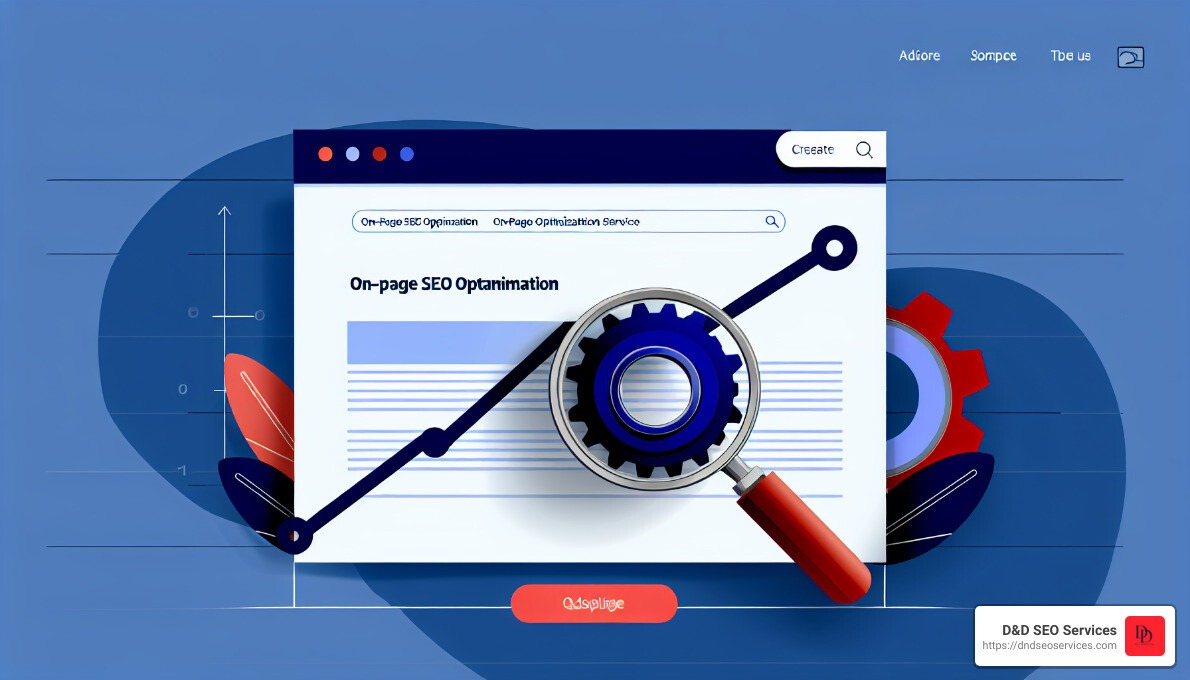Why On-Page SEO Optimization is Important
If you’re looking to boost your website’s visibility and improve your search engine rankings, on-page SEO optimization services are a must. They focus on enhancing various elements within your website to make it more search engine-friendly.
Here’s a quick snapshot of what you can do right away:
- Optimize Your Keywords: Choose high-value keywords and use them strategically across your content.
- Improve Meta Descriptions and Title Tags: Make them informative and intriguing.
- Improve Website Structure: Use internal links and well-organized URLs.
- Add Visual Elements: Photos, videos, and infographics can keep visitors engaged.
- Optimize Your Images: Use alt text and proper file sizes to boost performance.
By following these key practices, you can see better rankings and improved user experiences on your site.
I’m Danielle Birriel, founder of D&D SEO Services. With over a decade of experience helping small businesses thrive by leveraging on-page SEO optimization services, I am dedicated to enhancing your online visibility and site functionality.
Let’s dive deeper into how you can master on-page SEO and make your website a traffic magnet.
What is On-Page SEO?
On-page SEO is all about optimizing individual web pages to rank higher in search engines and attract more relevant traffic. Unlike off-page SEO, which focuses on external factors like backlinks, on-page SEO deals with elements you can control directly on your website.
Definition
On-page SEO refers to the practice of tweaking your website’s content and HTML to make it more search-engine friendly. This involves various tactics aimed at improving your site’s visibility in search engine results pages (SERPs).
Tactics
Here are some essential tactics for effective on-page SEO:
- Content Optimization: Ensure your content is high-quality, relevant, and includes the right keywords.
- Meta Tags: Optimize your title tags and meta descriptions to accurately reflect your page content.
- HTML Headers: Use header tags (H1, H2, etc.) to structure your content.
- URL Structure: Create clean, keyword-rich URLs.
- Internal Linking: Link to other pages within your site to help search engines understand your site’s structure.
- Image Alt Text: Use descriptive alt text for images to help search engines understand their content.
- Schema Markup: Add schema markup to help search engines understand the context of your content.
Individual Webpages
Each webpage on your site should be optimized individually. This means conducting a detailed audit to identify areas for improvement. Tools like Google Analytics and Google Search Console can help you understand how each page is performing and where you can make improvements.
Copy and HTML
Your site’s copy should be engaging and informative, while your HTML should be clean and efficient. This combination ensures that both users and search engines find your site valuable.
Search Engines
Search engines like Google use complex algorithms to determine how web pages are ranked. By optimizing your on-page elements, you help search engines understand your content better, which can lead to higher rankings.
Domain Authority
On-page SEO is crucial for maintaining a healthy domain authority. This is a measure of your site’s credibility and trustworthiness, which can significantly impact your rankings.
Organic Presence
By focusing on on-page SEO, you improve your site’s organic presence. This means your site is more likely to appear in search results without paying for ads, leading to more sustainable and cost-effective traffic.
Implementing these on-page SEO tactics can significantly improve your site’s visibility and user experience. Next, we’ll explore the key on-page SEO ranking factors to focus on.
Key Elements of On-Page SEO
Content Quality
Your content is the backbone of on-page SEO optimization services. High-quality content should be relevant, unique, and user-friendly.
- Relevance: Ensure your content answers user queries. For instance, if someone searches for “how to change a tire,” your page should provide clear instructions on that topic.
- Uniqueness: Avoid duplicate content. Google frowns upon content that appears elsewhere on your site or the web. Tools like Copyscape can help detect duplicates.
- User Experience (UX): Make your content easy to read and steer. Use short paragraphs, bullet points, and relevant images.
- Keywords: Use keywords naturally. Place them in the first 100 words, headers, and throughout the content without overdoing it.
- Authorship: Show expertise by including author bios. This builds credibility and trust with your audience.
- Shareability: Create content that people want to share. Engaging, informative, and valuable content can earn you more inbound links.
Meta Descriptions and Title Tags
Meta descriptions and title tags are crucial for signaling to search engines what your page is about.
- Optimization: Write custom meta descriptions and title tags for each page. Keep meta descriptions under 160 characters and title tags under 60 characters.
- Signaling: These elements help search engines understand the relevance of your page to specific queries.
- Relevance: Ensure your title and meta description accurately reflect the content. For example, a page titled “Best Pizza in Naples” should discuss top pizza places in Naples.
Image Alt Text and HTML Headers
Images and headers play a significant role in SEO.
- Image Optimization: Use descriptive file names and alt text for images. This helps search engines understand the content of your images and improves your visibility in image searches.
- HTML Headers (H1-H6): Use headers to structure your content. H1 tags should be used for the main title, while H2 and H3 tags can break down sections and sub-sections.
- Context: Proper use of headers makes your content easier to read and understand.
- Usability: Structured content is user-friendly, making it more likely to engage visitors and reduce bounce rates.
URL Structures and Internal Linking
URLs and links are vital for site navigation and SEO.
- URL Optimization: Create clean, short URLs that include relevant keywords. Avoid long strings of numbers and symbols.
- Keyword Inclusion: Place your primary keyword in the URL to help search engines understand the page’s topic.
- Internal Links: Link to other pages within your site. This helps search engines understand the structure and hierarchy of your content.
- Site Navigation: A well-structured internal linking strategy improves user experience by making it easier to find related content.
Schema Markup and Featured Snippets
Schema markup and featured snippets can significantly boost your visibility in search results.
- Schema Markup: Use structured data to help search engines understand the context of your content. This can lead to rich snippets in search results, which are more engaging for users.
- Featured Snippets: Aim to provide clear, concise answers to common questions. Google often pulls this information into featured snippets, which appear at the top of search results.
By focusing on these key elements of on-page SEO, you can improve your site’s visibility, user experience, and search engine rankings. Next, we’ll dive into how to conduct an on-page SEO audit to identify areas for improvement.
How to Conduct an On-Page SEO Audit
Conducting an on-page SEO audit is essential for identifying areas where your website can improve its visibility and ranking. Here’s a step-by-step guide to help you through the process.
Keyword Research
Keyword research is the backbone of any successful SEO strategy. Here’s how to do it:
- Advanced Keyword Research: Use tools like Google Keyword Planner and Ahrefs to find high-traffic, low-competition keywords relevant to your business.
- Search Intent: Understand what users are looking for when they type in your target keywords. Are they looking for information, buying a product, or seeking a local service?
- Target Keywords: Identify primary and secondary keywords for each page. Ensure they align with your content and business goals.
Example: If you run a bakery in Naples, your target keywords might include “best bakery in Naples” or “fresh bread Naples.”
Content Analysis
Next, review your website’s content to ensure it meets SEO best practices:
- Content Refreshes: Regularly update your content to keep it relevant. Fresh content is more likely to rank well.
- Blog Post Optimization: Ensure your blog posts are optimized for your target keywords. Include these keywords naturally in your headings, subheadings, and body text.
- Product Descriptions: Optimize product pages with unique, keyword-rich descriptions. Avoid duplicate content, as it can hurt your rankings.
Tip: Always focus on user experience (UX). Content should be engaging, informative, and easy to read.
Technical SEO
Technical SEO ensures that search engines can easily crawl and index your site. Here are the key aspects:
- Site Audits: Use tools like Screaming Frog and Google Search Console to identify technical issues such as broken links, crawl errors, and duplicate content.
- Error Remediation: Fix any errors identified in your site audit. This includes 404 errors, server errors, and any issues with your robots.txt file.
- SSL Setup: Ensure your site is secure by setting up SSL (HTTPS). Google gives preference to secure sites, and it also builds trust with your users.
- Google Analytics Tracking: Set up Google Analytics to track your site’s performance. Monitor metrics like pageviews, bounce rates, and conversion rates to understand how users interact with your site.
Fact: Google has confirmed that page speed is a ranking factor. Ensure your pages load quickly on all devices.
By following these steps, you can conduct a comprehensive on-page SEO audit that highlights strengths, identifies weaknesses, and provides actionable insights for improvement. Next, we’ll explore best practices for on-page SEO optimization.
Best Practices for On-Page SEO Optimization
Optimizing URLs and Meta Descriptions
URLs and meta descriptions are crucial for on-page SEO optimization service. They help search engines and users understand your content.
- Short URLs: Keep your URLs short and sweet. Google gives more weight to the first 3-5 words in a URL. For example, “yourwebsite.com/best-running-shoes” is better than “yourwebsite.com/page1.”
- Keyword Inclusion: Include your target keyword naturally in the URL. This boosts relevance and helps search engines understand the page content.
- Descriptive Meta Descriptions: Write meta descriptions that are compelling and relevant. Aim for 150-160 characters. Include your target keyword at least once. This helps catch users’ eyes in search results.
Using Header Tags and Keywords
Headers and keywords structure your content and improve readability.
- H1 and H2 Tags: Use H1 tags for the main title and H2 tags for subheadings. This structure helps both users and search engines understand your content.
- Keyword Placement: Place your target keyword in the H1 tag and at least one H2 tag. This signals the importance of the keyword to search engines.
- Readability: Break up your content with headers. This makes it easier for users to scan and find the information they need.
Enhancing User Experience
A great user experience keeps visitors on your site longer, which can improve your rankings.
- Mobile Optimization: Over half of web traffic comes from mobile devices. Use Google’s Mobile-Friendly Test to check your site’s mobile usability. Ensure your site adapts to different screen sizes.
- Responsive Design: Make sure your website adjusts to various devices. This improves user experience and search rankings.
- Page Performance: Fast load times are crucial. Compress images, minify CSS and JavaScript, and consider upgrading hosting if needed. Google has confirmed that page speed is a ranking factor.
By following these best practices, you can significantly improve your site’s on-page SEO. Next, we’ll discuss the benefits of on-page SEO optimization services. These services can enhance user experience, leading to lower bounce rates and higher engagement. As you master onsite SEO strategies, you’ll also notice improvements in your site’s visibility on search engines, attracting more organic traffic. Ultimately, a well-optimized website can drive conversions and help achieve your business goals more effectively.
Benefits of On-Page SEO Optimization Services
Improved Search Rankings
On-page SEO optimization services help your website rank higher in search engine results. By optimizing elements like title tags, meta descriptions, and keyword placement, search engines can better understand and index your content. This means your site is more likely to appear for relevant queries.
For example, a study showed that pages with optimized meta descriptions see a 5.8% increase in click-through rates. Better indexing means higher visibility, which leads to more traffic and potential customers.
Improved User Experience
A well-optimized site isn’t just good for search engines; it’s also great for users. Structured content, clear headings, and easy navigation make your site more user-friendly. This keeps visitors on your site longer and reduces bounce rates.
Easy Navigation: Internal linking and a clear site structure make it easier for users to find what they’re looking for. This improves user engagement and sends positive signals to Google.
Increased Engagement: When users find your content valuable and easy to read, they are more likely to stay and interact with your site. This not only improves user experience but also boosts your search rankings.
Increased Organic Traffic
Higher search rankings and better user experience naturally lead to increased organic traffic. When your site ranks well for targeted keywords, you attract more visitors who are interested in what you offer.
More Opportunities: With higher visibility, you get more chances to convert visitors into customers. Optimized content ensures that the traffic you attract is relevant and likely to engage with your offerings.
Higher Conversions: Quality content and a user-friendly site make it easier for visitors to take action, whether it’s making a purchase or signing up for a newsletter.
Competitive Advantage
Effective on-page SEO can set you apart from competitors who may not be investing in these critical optimizations. By focusing on high-value keywords and quality content, you can establish your site as a credible source of information.
Credibility and Authority: Optimized content showcases your expertise, making your site more trustworthy. As your content ranks higher, your site gains more authority in your industry.
Alignment with Business Goals: On-page SEO allows you to target keywords and topics that align with your business objectives. This ensures that the traffic you attract is not just high in volume but also high in quality.
By leveraging on-page SEO optimization services, you can improve your site’s visibility, improve user experience, and drive more organic traffic. Next, we’ll address some frequently asked questions about on-page SEO optimization services.
Frequently Asked Questions about On-Page SEO Optimization Service
What is on-page SEO?
On-page SEO is the practice of optimizing individual web pages to improve their search engine rankings and attract more relevant traffic. It focuses on elements you can control on your website, such as content quality, keyword usage, metadata, and internal linking.
Think of on-page SEO as setting up a storefront. You want everything to be neat, organized, and easy to find. This makes it more likely that both people and search engines will find what they’re looking for and come back for more. For example, using descriptive title tags and meta descriptions helps search engines understand what your page is about, making it easier to rank higher for relevant searches.
Why is on-page SEO important?
On-page SEO is crucial because it helps search engines understand the content of your web pages. When you integrate keywords into your content and use clear titles and meta descriptions, you make it easier for search engines to rank your site higher. Here are some key benefits:
- Improved Search Rankings: Better rankings mean more visibility. Optimizing on-page elements helps search engines index your content effectively, leading to higher rankings for relevant queries.
- Improved User Experience: Well-structured and optimized pages are easier to steer, increasing user engagement and potentially boosting conversion rates.
- Increased Organic Traffic: Higher rankings and a better user experience naturally attract more visitors, offering more opportunities for conversions.
- Competitive Advantage: Effective on-page SEO can set you apart from competitors who overlook these basics.
- Alignment with Business Goals: By targeting relevant keywords, you attract a more focused audience, increasing the likelihood of achieving your business objectives.
How often should I optimize my website’s on-page elements?
It’s generally a good idea to review and update your website’s on-page SEO on a regular basis, especially if you are regularly adding new content or making significant changes to your website. How often you need to optimize will depend on the specific needs of your website and the competition within your industry.
Here are some guidelines:
- Monthly: Analyze high-performing pages and update content if you notice a drop in rankings. Refreshing old content can boost its relevance and search ranking.
- Quarterly: Conduct a comprehensive on-page SEO audit, including keyword research, content analysis, and technical SEO checks.
- Annually: Perform a deep dive into your overall SEO strategy, including a competitive analysis and keyword strategy refresh.
By keeping your on-page SEO elements updated, you ensure that your website remains relevant and competitive in search engine rankings.
Conclusion
At D&D SEO Services, we understand that every business is unique. That’s why we offer personalized strategies custom to fit your specific needs. Whether you’re a local business looking to increase your online visibility or a larger company aiming for robust growth, our team has you covered.
Local Markets
Local SEO is more important than ever. According to D&D SEO Services, 97% of search engine users search online to find a local business. Our strategies are designed to help you dominate those local search results, ensuring that your business is easily found by potential customers in your area. From optimizing your Google Business Profile to building local citations, we make sure your business stands out.
Online Visibility
Good online visibility is crucial for any business. Our team uses cutting-edge optimization techniques to improve your website’s performance. By integrating tools like Google Analytics and VWO’s heatmap generator, we track user behavior to understand what works and what doesn’t. This data-driven approach allows us to make informed decisions that improve your online presence.
Business Growth
Our ultimate goal is to drive business growth for our clients. We achieve this by focusing on both short-term wins and long-term strategies. Whether it’s through optimizing your website for conversions or implementing effective content marketing, we ensure that every aspect of your digital presence is fine-tuned for success.
Why Choose D&D SEO Services?
With over a decade of specialization in SEO and digital marketing, D&D SEO Services stands as a trusted partner for businesses looking to lift their online presence. Our comprehensive approach ensures that you not only reach your target audience but also engage and convert them.
Ready to open up the power of optimization techniques for your business? Contact us today to get started on your journey to online success!
By integrating these strategies, we help you create a stronger digital narrative that resonates with your audience, fostering growth and sustained customer relationships.







